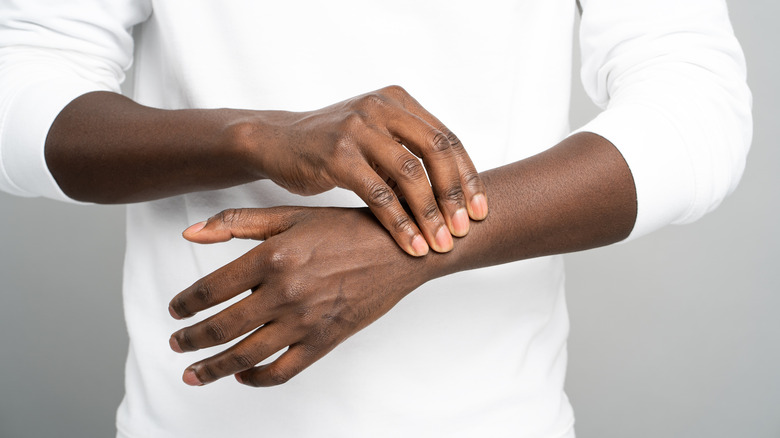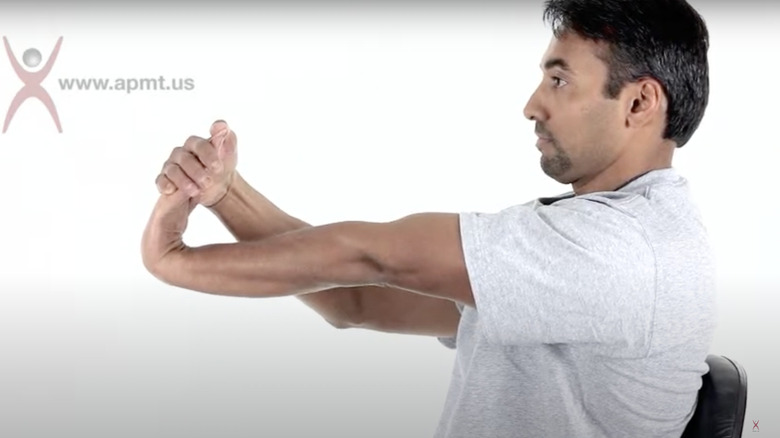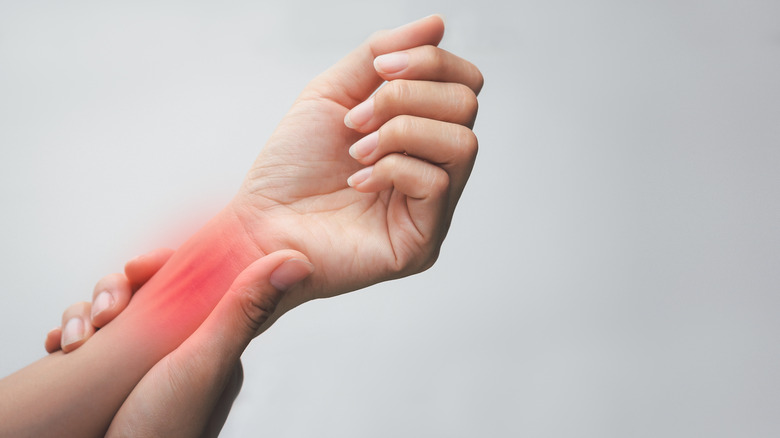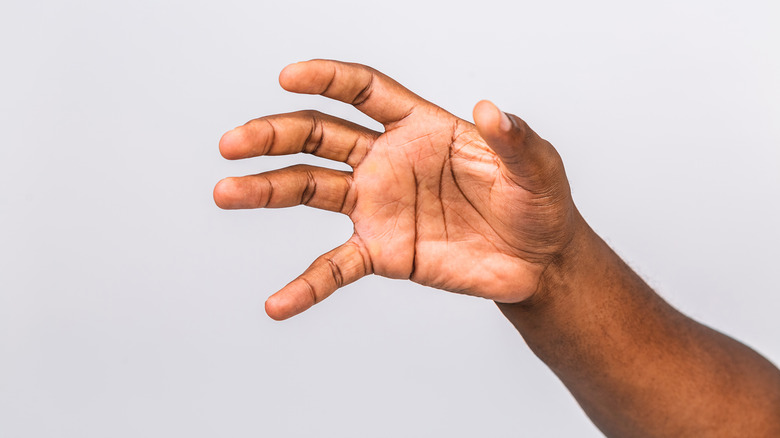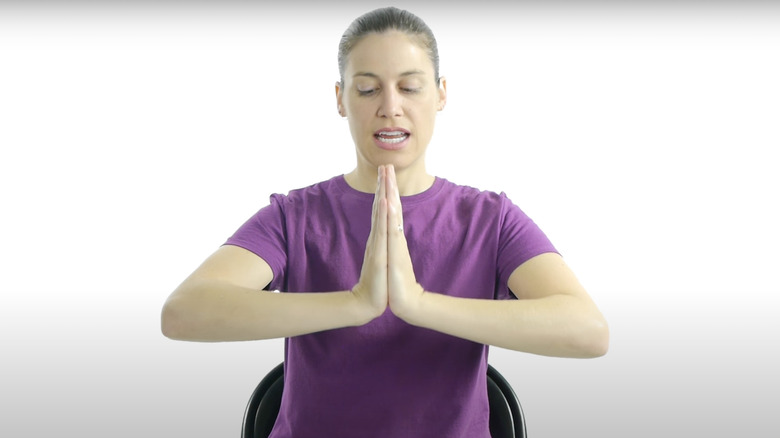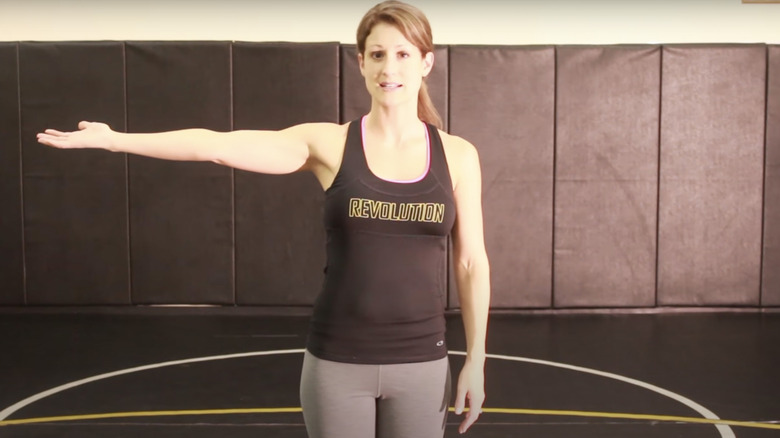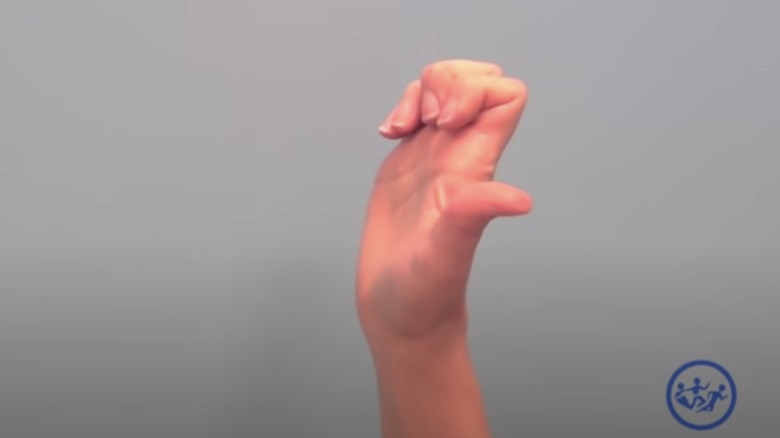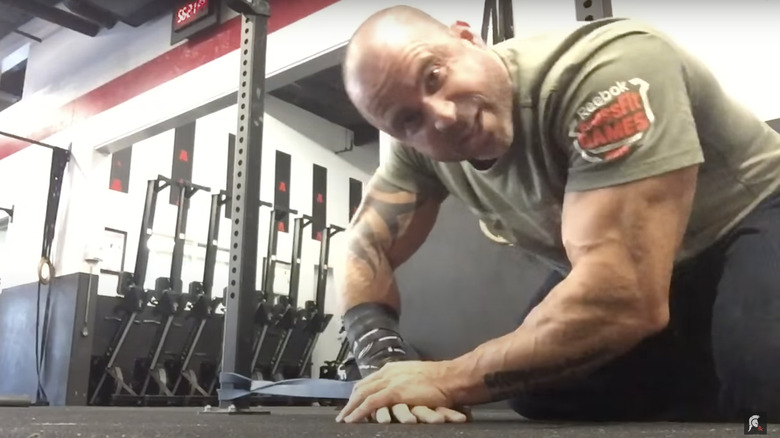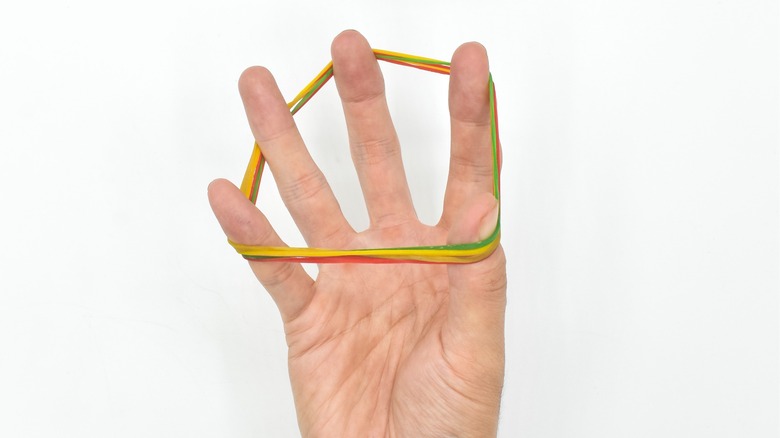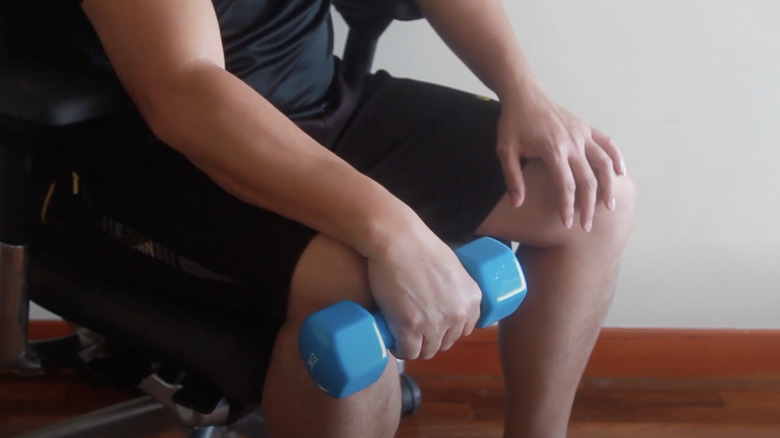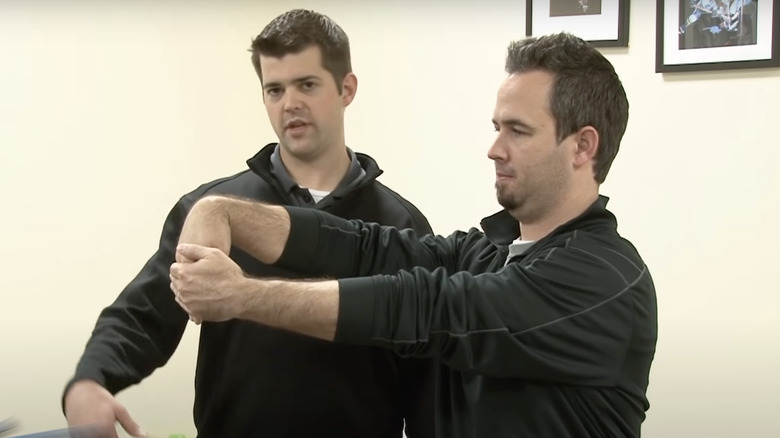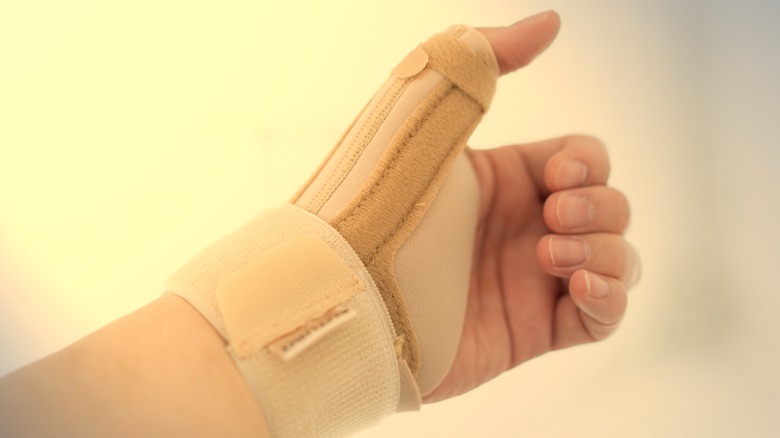The Best Exercises For Carpal Tunnel
If you've experienced carpal tunnel, you're not alone. The nerve condition, which generally affects people through their wrist and hand, impacts between 4 and 10 million Americans (per the American College of Rheumatology), and it's far from a pleasant experience. Causing pain, discomfort, and even loss of function throughout the hand and wrist, carpal tunnel can occur when you least expect it. And although women and people who have metabolic conditions are way more likely to develop carpal tunnel, according to the National Institute of Neurological Disorders and Stroke, it's a condition that can affect everyone, and when it strikes, it's important to act fast.
But whether you're currently experiencing the condition or you're in recovery from surgery or treatment for the nerve disorder, you must take care of the area that carpal tunnel affects the most. Although your doctor may recommend a range of treatments, performing regular gentle exercises involving the hand and wrist area can ease discomfort and speed up recovery. But what exercises are the best? Well, that's where we step in, folks. Let's take a look at our top picks.
Why does carpal tunnel occur?
With the wide-ranging and sometimes baffling symptoms that carpal tunnel can cause, it can be difficult to understand entirely why your hand or wrist is feeling as it is. Well, it's all down to one specific nerve. The carpal tunnel is, in effect, a tunnel (the clue's in the name, folks!) on the palm side of your hand, which nestles between your bones and ligaments, and through which your median nerve passes (per the Mayo Clinic). The median nerve supplies your thumb and several of your fingers with motor function and sensation. Now and again, though, this nerve can become pinched or compressed in the carpal tunnel, and when this occurs, you might start to experience the tingling, numbness, or pain that indicates carpal tunnel syndrome.
Carpal tunnel can be caused by a wide range of things, and your risk of developing it can be raised by a variety of environmental and physical factors, from your anatomy to any pre-existing medical conditions, to the type of work you do and any repetitive movements you might be making. It's usually the case that there's no one reason why you develop carpal tunnel, and it's a combination of things that lead to it.
Stress ball squeeze
There are few things better than a good old stress ball when things get too much. These small, soft-ish spheres are a surprisingly powerful tool for releasing tension and anxiety and providing a benefit to our nervous system, according to therapist and mental health counselor Michelle Hunt via Healthline. And if you're experiencing carpal tunnel, breaking out your old stress ball to squeeze it could be the best thing to improve your condition. Not only will your stress ball help you feel less irritated by the carpal tunnel itself, but it will also improve your grip strength and muscular strength through your wrist and forearm, which can be diminished when you have carpal tunnel, thanks to your median nerve being compressed (per City Place Surgery Center).
To do a simple stress ball squeeze, it couldn't be easier. Grab a ball and place it in the center of your hand. Then, squeeze firmly, and hold it for ten seconds or so. Release the tension, and then repeat five times. Consistency is key here, so repeat the squeezes every day or every other day, for a total of three to five times a week.
Wrist extension
Your carpal tunnel runs through your wrist, and as such, exercises that involve generating flexibility and movement in the joint are paramount to improving your condition. But movements that mobilize your wrist will also allow you to provide relief and tension to the rest of your carpal tunnel, which runs up to your forearm, as the National Institute of Neurological Disorders and Stroke discusses.
A wrist extension exercise will do just that. Stand up straight with your shoulders back and your hands by your sides, and then raise your affected arm out in front of you at shoulder height, your palm facing the wall as though performing a "stop" signal (per Medical News Today). Keep a slight bend in your elbow. Then, raise your other arm, and hold the fingers of your affected hand. Lightly pull the fingers back, generating a stretch through your inner forearm, and hold the position for between 10-15 seconds. Release your hand, and allow it to rest. Repeat the movement five times. If desired, you can also perform the stretch on the other side, or keep it to the hand that has the carpal tunnel specifically. We'd recommend doing this set of stretches every day if you can, or however many times is comfortable.
Shaking it out
Sometimes, folks, the simplest movements are the best. And if it's been a little while since you've practiced the "shake it all about" section of the Hokey Pokey, you'll be a big fan of this move — especially if you're experiencing carpal tunnel.
Simply stand up straight, or sit with your back straight, and hold your hands out in front of you, your arms bent at the elbow, according to Healthline. Then, shake out your hands! Imagine that you're trying to dry them off when they're slightly wet, like after you've washed your hands or applied hand sanitizer. It might sound like a simple movement, but we guarantee that it has a clear function, especially if you're doing it regularly. "Do this for a minute or two every hour to keep flexor muscles of your hands and its median nerve from getting cramped and tight during the day," advises Vermont-based doctor of physical therapy John DiBlasio. And if you need a little more inspiration or motivation? Stick on a soundtrack, and practice your other dance moves. (Wearing the costumes, though, is not required).
Thumb touches
Oftentimes, carpal tunnel syndrome will clear up without surgical intervention, but in other cases, a procedure may be needed. Surgery is especially recommended if you've been experiencing carpal tunnel for a while or if your symptoms are especially severe, and it can be effective in releasing pressure on your median nerve and preventing chronic damage and pain (per Alberta Health Services).
Following surgery, however, your mobility may be compromised, and it can take a while for everything to return to normal (per ProFysio Physical Therapy). Performing rehabilitation exercises can allow your recovery to move faster, and will assist you in regaining your usual dexterity and movement. Thumb touches are a quick and easy exercise. Hold your hand out in front of you, with your palm facing the sky. Your fingers should be spread apart. Then, using your index fingers first and moving through the other fingers in your hand, touch each fingertip to your thumb tip. Once you get to your pinky finger, move back in the other direction, ending with your index finger. Cycle back and forth through your fingers for three to five complete sets of thumb touches, repeating several times throughout the day and week.
Prayer stretch
If you've recovered from carpal tunnel, or your pain and discomfort have subsided, then you'll likely not want to experience it again. Ensuring that you're doing regular exercises to keep your wrists and arms mobile and healthy can help you do this, and the prayer stretch is a great place to start.
Begin in a standing position, with your feet shoulder-width apart and your shoulders rolled back, and then place your hands together in front of you, in a prayer position, Alberta Health Services says (we recommend taking a look at the "pray" emoji for a visual, very instructive). Your hands should be at chest height. Then, keeping your hands pressed together, slowly push your hands downward, so that they become level with your waist. As you do this, you should start to feel a stretch through your forearms, which will increase the more that you lower your hands. Keep the stretch for up to 30 seconds at a time, and then release, repeating between two to four times a day. Bear in mind that if you're in recovery from carpal tunnel, you'll want to be gentle here — don't go any further than is comfortable.
Median nerve stretch
The nerve that plays such a big part in carpal tunnel syndrome is called your median nerve, and while it primarily causes trouble in your forearm and wrist, it actually starts up in your armpit (per the Cleveland Clinic). The body's wild, right? And as you might imagine, finding ways to mobilize and stretch your median nerve is imperative to keeping the nerve free of the compression or damage that causes carpal tunnel.
That's where the median nerve stretch comes in. While most carpal tunnel stretches focus on the wrist and hand area, the median nerve stretch gives you a stretch through your whole arm, as Vive Health says. Stand up straight and hold your arm out in front of you, extended entirely. Then, without allowing your chest or torso to rotate, move your arm out to the side, and draw it back as far as it will extend behind you. When your arm is at its limit in the stretch, pull your hand back even further, which will activate the median nerve. To gain a little extra mobility, extend and flex your wrist several times in this position.
Tendon glides
Trust us when we say that tendon glides are one of the best things you can do for carpal tunnel. In fact, there are two different types of tendon glide you can do to ensure that you're getting maximum mobility (per WebMD). For the first kind, begin by holding your arm up with your palm facing your face, and straighten out all of your fingers and your thumb. Then, make a "hook" or curved shape with your fingers, bending your knuckles, ensuring that they're facing the ceiling. Continue the movement of your fingers so that they make a fist, squeezing fairly tightly, and then return your hand to the hook shape, repeating the motion up to ten times. Perform the glides several times daily.
For the second tendon glide, start in the same position as you did for the first. But this time, instead of bending your fingers into a curved shape, keep them straight and bend them down so that they're at a right angle to the back of your hand. Allow them to continue moving until they touch your palm, and then return to the starting position, again repeating up to ten times, several times a day. If your pain or stiffness is especially acute, it may be useful to heat your hand and wrist area for 10-15 minutes before performing the tendon glides, and apply an ice pack to the area after.
Spiders doing pushups on a mirror
Of all the exercises that you can do to treat carpal tunnel, this one definitely has the best name, hands down (if you'll excuse the hand-related pun). And what is already a name for a well-known nursery rhyme, spiders doing pushups on a mirror is also a superb movement to protect your wrists and ease pain and stiffness (per Healthline). "This stretches the palmar fascia, carpal tunnel structures, and median nerve, the nerve that gets irritated in a carpal tunnel syndrome," doctor of physical therapy John DiBlasio says of the move.
Begin by standing with your arms flexed at the elbow, and bring the tips of all of your fingers and both of your thumbs on each hand together, with your fingertips pointing toward the floor and your thumbs pointing toward your head. Your fingers and thumbs should be spread as widely as possible. Then, gradually move your palms outward, so that your fingers come up, and your thumbs move down, without removing the fingertips from each other. Your hand should move in a steeple or almost a concertina motion. Push your palms back in toward each other to move the fingers back to the original position, and repeat.
Wrist lift
With your hand, wrist, and forearm all being interconnected, it's important to recognize that when you're dealing with carpal tunnel, tending to all these areas will allow you to recover faster. And oftentimes, exercises that involve the wrist are focused on stretching and strengthening your forearm.
The wrist lift is such a movement. To do this exercise, you'll need a table or a flat surface to lay your palm on, Medical News Today advises, or place your hand on the floor, kneeling over it. Place your affected hand flat on the surface, with your fingers separated naturally, and then lay your other hand across the top of the flat one, so that your fingers are over the knuckles. Try to keep your hands at a right angle to each other. Then, while applying pressure with your top hand to the lower one, try and lift your lower hand off the table. Applying constant pressure in both directions, hold the lift for around five seconds or so, and then release the tension. Repeat the motion up to ten times per set.
Rubber band finger extensions
When we're treating medical conditions, it may be tempting to rush out and buy yourself endless amounts of pricey gear in an effort to cure yourself. But in truth, sometimes all you need is a good old-fashioned rubber band, and you're good to go! Rubber band finger extensions are a great way to generate mobility and strength in a carpal tunnel-affected hand and potentially avoid more invasive treatment (per City Place Surgery Center).
Hold your hand out in front of you, with your palm facing the ceiling and your fingers in a curved position, and place a rubber band around the outside of your fingers and thumb. Then, gently extend your fingers and thumb outward, bringing them back in after they've reached their maximum extension, and repeat for one minute. Do this for three sets. Naturally, the more resistant or small your rubber band, or the more bands you have, the more difficult this move will be to complete — so you may want to try out a few different sizes or combinations to see which is right for you. If you only have one large band, you can wrap it around your fingers several times to increase the tension.
Wrist stretch with weights
When you're dealing with carpal tunnel, you'll usually be working with smaller, more delicate movements that require little resistance. But occasionally, a touch of extra weight is useful, especially to build strength in the wrist and forearm. That's where a wrist stretch using weights comes in handy, which works to stretch and mobilize your forearm flexor muscles (per Medical News Today).
Sit next to a flat surface, or with your forearm on your thigh, and lay the forearm of your affected hand/wrist flat on it, with your hand hanging over the edge. In your hand, you should hold a handheld weight. The weight of it will depend on your comfort level, but you probably won't need anything too heavy — even a can of beans will do. Let the hand holding the weight drop gently so that it's hanging fully down. Then, slowly roll your wrist back and your hand up until it reaches its maximum height. Allow your hand to lower back down until it's in its original position. Repeat the movement for a total of ten times per set (you'll want to do three sets maximum).
Wrist flexion stretch
It's important to remember that carpal tunnel exercises shouldn't be considered isolated movements that have no relation to the rest of your day — they should exist alongside your life, and work to make your other movements safer. The wrist flexion stretch is a great exercise for just this and should be performed before any activities that will involve the wrist or arm, or before any gripping movements (per the American Academy of Orthopaedic Surgeons).
Begin by extending your arm out in front of you, with your palm facing the floor. Avoid locking your elbow as you do so. Let your wrist bend down so that your fingers and hand are parallel to your arm, and then bring your other hand to grip the fingers of your bent hand. With your gripping hand, pull your bent hand gently back toward your body, until you feel a stretch through the top of your forearm. To increase the stretch, place your fingers a little higher on the back of your hand. Hold the stretch for 15 seconds and then release, for a total of five reps. You can do this stretch up to four times a day, every day should you desire.
What if my carpal tunnel doesn't improve?
While performing exercises will help your carpal tunnel in a lot of cases, there are situations where, despite you being diligent with your stretches, things may not improve (via City Place Surgery Center). And if you're finding that your symptoms aren't improving, or they're getting worse, it's important to act fast. The first thing you should do is speak to your doctor, who may ask you to undergo some tests to rule out that your pain and discomfort might be caused by another condition, according to Harvard Health Publishing. If it is indeed carpal tunnel, they may ask you to wear a splint at night and could prescribe you simple NSAID medication to treat pain.
In certain situations, however, surgery is not only advised, but important to get. "The mistake that people often make is waiting too long to get surgery. I see a lot of people who say that their numbness was gradually worsening and now their hand is completely numb and has been for a year," says Beth Israel Deaconess Medical Center chief of hand and upper extremity surgery Dr. Tamara Rozental to Harvard Health Publishing. The risk of long-term damage from carpal tunnel is significant, and you could be faced with permanent symptoms and difficulties.

